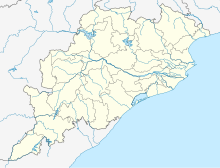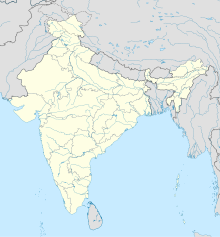|
Bengal Sultanate conquest of Orissa
The Bengal sultanate conquest of Orissa in 1568 was a military campaign led by the Karrani dynasty of the Bengal Sultanate under Sulaiman Khan Karrani. The objective was to overthrow the Chalukyan rule of Orissa (now Odisha) under Mukunda Deva and the rebellion led by Sarangagarh feudatory Ramachandra Bhanja. The Bengal forces achieved victory, resulting in the annexation of Odisha into the Sultanate. Odisha remained part of the Bengal Sultanate until its eventual annexation by the Mughal Empire in 1592.[1] BackgroundPreludeIbrahim Shah Suri, defeated by Adil Shah Suri due to his rebellion against the Sur dynasty, sought refuge in Bengal. However, Sulaiman Karrani, the Karrani ruler of Bengal, attempted to detain Ibrahim Khan Suri. Recognizing the danger, Ibrahim Khan Suri appealed to Mukunda Deva, the ruler of Odisha, for shelter and assistance.[2] Mukunda Deva, of Chalukya descent, ascended to the throne by ousting Raghuram Raya Chotaraya, the Bhoi ruler of Odisha.[3] Responding to Ibrahim's plea, Mukunda Deva not only offered refuge but also granted him land as a mark of honor. Mukunda Deva firmly rejected surrendering Ibrahim to the Karranis, sparking animosity from Sulaiman, the ruler of Bengal.[4] Involvement of the MughalsBy this time, the Mughal Empire, led by Humayun, achieved victory over Sikander Shah Suri at the Battle of Sirhind, successfully reinstating Mughal rule over India. This triumph marked the recovery of territories that had previously been lost to Sher Shah Suri. One year following the Battle of Sirhind, Humayun passed away, leading to Akbar ascending to the throne of the Mughal Empire.[5] Recognizing tensions between the Bengalis and the Odias, Akbar, with the aim of annexing Bengal into the Mughal Empire, chose to support the Odias. Establishing diplomatic ties with Mukunda Deva, he forged an alliance. Akbar dispatched Hasan Khan Khajanchi and Bhatta Mahapatra, an Odiya musician from the Mughal Court, as envoys to Mukunda Deva's court. Their mission was to secure support in case of a conflict with the Sultan of Bengal.[6] The envoys spent four months at Mukunda Deva's court and returned with valuable gifts and elephants. Simultaneously, Mukunda Deva's ambassador, Parmanand, accompanied them to the Imperial Court. This diplomatic maneuvering marked the beginning of an alliance between Akbar and Mukunda Deva.[6] Mukunda Deva's alliance with the Mughals heightened the animosity between him and Sulaiman, prompting the latter to launch a campaign against the Chalukyas. Concurrently, Mukunda Deva seized a portion of Karrani territory, provoking swift retaliation.[7] The conquestIn January 1567, Mukunda Deva launched an invasion of Bengal, having a victory over the Bengal forces and amassing significant wealth. Setting up camp along the banks of the Ganges, he engaged in military exercises, including boat maneuvers on the river. Remarkably, this marked the final instance when the Odisha army reached the banks of the Ganga.[7] In the winter of 1568, as Akbar was besieging the Chittor fort, Sulaiman seized the opportunity to invade Odisha.[2] The Karrani army operated in two divisions: one led by Sulaiman Karrani and the other by Bayezid, Sulaiman's son, assisted by Kalapahar.[8] Advancing towards Odisha, the Bengal forces reached the coastal area near Balasore. Realizing the absence of support from the Mughals, Mukunda dispatched an army led by his trusted officers, Chhotarai and Raghubhanja. But these officers betrayed Mukunda and defected to the Bengal side against their own ruler.[7] OutcomeThe records present two different accounts of the outcome of this campaign. First versionAccording to Mandala Panji, the Bengal army, led by Sulaiman, engaged in a conflict with Mukunda's Chalukya forces. In this encounter, Mukunda's forces suffered defeat and sought refuge within the Kotsimul fort in the Hoogly district of West Bengal. Simultaneously, another segment of the Bengal army, commanded by Bayezid and Kala Pahar, laid siege to Cuttack, the capital of Odisha, against Koni Samanta Simhara. In this confrontation, Simhara was defeated and killed.[8] During this period, Ramachandra Bhanja, the commander of Sarangagarh, staged a revolt and proclaimed himself as the ruler. Ramachandra was the feudatory of the Bhoi Gajapatis, whom Mukunda Deva had assassinated. Acknowledging this development, Mukunda Deva made a treaty with the Karranis and moved to confront Ramachandra. However, in the ensuing battle, Mukunda Deva was defeated and killed by Ramachandra. Later, Ramachandra was killed by the Karranis on the following day.[9][10][1] Second versionThe alternate account of this event, as presented in the Akbarnama, indicates that Mukunda Deva met his demise in the battle fought at Jajpur. According to this version, the Karranis emerged victorious, defeating the Chalukyas.[7] The first version is widely regarded as the most accurate account.[11] Kalapahar, the commander of the Karrani dynasty, inflicted a severe blow to the art and architecture of Odisha by destroying temples and images. This destructive episode is considered a significant tragedy in the cultural heritage of the region.[12] AftermathThus, in A.D. 1568, Orissa's medieval independence came to an end. Subsequently, Orissan prestige suffered, with local kings becoming mere puppets under Muslim governors. Orissa remained a part of the Bengal Sultanate until it was annexed by the Mughal Empire.[7] References
|
||||||||||||||||||||||||||||||||

